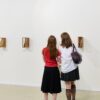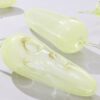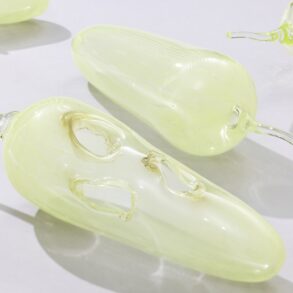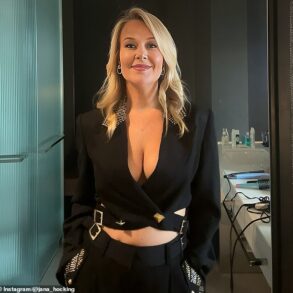One of the world’s largest collections of work by women artists is coming to Berkeley this season, courtesy of a Haas School of Business alumna who has brought her prodigious collection to her alma mater’s flagship art museum.
This past weekend, the Berkeley Art Museum and Pacific Film Archive (BAMPFA) opened Making Their Mark: Works from the Shah Garg Collection — the first-ever museum presentation of a celebrated art collection assembled by Komal Shah, who graduated from the Haas School of Business in 1997.
Drew Altizer Photography courtesy of BAMPFA
As both an art lover and a successful businesswoman who came up in the male-dominated tech sector, Shah rails against the massive earnings gap between women artists and their male counterparts, a discrepancy that has been stubbornly persistent for decades. To counter this dismal trend, Shah has used her collecting practice — as well as her philanthropic work through the Shah Garg Foundation, which she runs with her husband Gaurav Garg — to champion the work of women artists, in pursuit of a more gender egalitarian art world.
This inclusive spirit is vividly on display in Making Their Mark, which features works by nearly 70 women artists from the postwar period to the present day. In assembling the exhibition, which debuted at a New York gallery to national acclaim before traveling to Berkeley, Shah and the curators organized works from different eras in dialogue with each other to illuminate intergenerational connections between women artists of the past and present. While most of the artworks are abstract rather than figurative, the influence of a female perspective subtly infuses the entire exhibition, particularly in the prevalence of many weavings and other textile works, a historically female-coded medium that has often been marginalized as “craft” by a mostly male art establishment.
In conjunction with the exhibition’s opening in Berkeley, Shah spoke with UC Berkeley News about her collecting practice, the goals of the exhibition, and what it feels like to be back on campus after all these years.
UC Berkeley News: Let’s start by bringing readers up to speed with your history as a collector. What sparked your interest in collecting work by women artists, and how has your collecting practice evolved over time?
Komal Shah: I worked in the tech world for about two decades at various companies like Oracle, Netscape, Yahoo and Qlue (acquired by ServiceNow). I was ambitious and hardworking and believed that the gender-based glass ceiling did not apply to me. I helped grow a business tenfold from $10MM annually to over $120MM in my late twenties after graduating from Haas in 1997. However, in 2008, I decided to opt out of a full-time career to help our son with occupational therapy. (He is now an award-winning race car driver, thank God!)
While my husband Gaurav Garg and I had always enjoyed going to museums and looking at works by abstract expressionists like Mark Rothko and Willem De Kooning, my early retirement from tech allowed me to join museum groups on art tours across the country and learn from curators. I started dabbling in collecting art without a focus. It was really at the Whitney Biennial in 2014 that I first experienced the heart-thumping, pulse-quickening, visceral response to two paintings. It turned out that both works were created by women artists, Laura Owens and Jacqueline Humphries.
Drew Altizer Photography courtesy of BAMPFA
As I started to get to know them and other artists like them, I started noticing a perception bias against women artists. Upon further reading and learning I realized that the gender-based bias was rampant in the art world and even more pronounced for artists who are older women. That’s when it all came together for me — that our collection would tell the story of excellence in art with works made by women artists. We would focus on abstraction, as abstraction not only blurs the boundaries of geography, race and gender, but it was also a domain that had been denied to women.
Now we have over 200 artists that identify as female in the Shah Garg collection. We continue to acquire works made by both emerging and established artists. But I prioritize acquiring works by artists older than 70 years, as they have persisted and maintained their level of excellence in their art practice despite little recognition by the art world.
You graduated from Haas in 1997 and served on the school’s board of trustees. What was your experience like as a business student on the Cal campus, and how do you think that experience might be different for Haas students today?
I attended the Evening MBA (EMBA) program at Haas while working full time at Oracle, initially as an engineer and then as a Product Manager. We would attend classes two evenings a week from about 6 to 9:30 pm after a full workday. However tired we’d be, once we would reach the campus, we were recharged and ready to learn because of the infectious energy in the air and the inspiring faculty. While I missed the all-in experience of a full time student, it was meaningful to apply the learnings at work immediately.
When I was a student at Berkeley, we were very excited about the internet and felt that the tech world was on the precipice of a major change. Over the last 25 years, there have been quite a few shifts in the landscape. Product management (my line of work) is much more established as an indispensable function in most companies. DEI is now recognized as critical to our business world, and leaders need to embrace diversity while respecting individuality. Today’s leaders also need to be adept at handling an increasingly heated political climate.
Drew Altizer Photography courtesy of BAMPFA
Were there any formative experiences at Haas that shaped how you approached your career in the tech sector? Your work as a philanthropist and art collector?
Balancing a demanding job with a substantive MBA program was by itself a formative experience! Additionally, the curriculum at Haas helped me grow from being an engineer to a product exec, by supplementing my hardcore computer science experience with people and business skills.
The learnings have also been helpful with the art world, which can be quite opaque for a new collector. I found the culture at Haas to be one of doing well and good without arrogance, and that encouraged being open to taking risks. That culture served me well as collecting works by women was against the grain of the common collecting wisdom at that time. But recognizing that these works were undervalued assets and having a strong belief that “equity and excellence are not mutually exclusive” gave me the courage to build a comprehensive art collection by women artists, with an audacious aim to level the playing field in the art world.
One of the projects that we undertook on the board of EGAL and Haas was to look at income parity for women Haas MBA alums, and we were pained to learn that the numbers eventually stood at women making 65 cents on the dollar. In the art world, as reported by The Guardian in 2023, women artists make 10 cents on the dollar. Being at Haas certainly sensitized me to the importance of surveys and key progress indicators as a reality check in any industry.
You’ve chosen to present Making Their Mark at BAMPFA, where it will be seen by countless students from across the UC Berkeley campus. As someone who knows what it’s like to be a student at Cal, what do you hope that today’s students — especially young women — will learn, experience, or discover upon seeing this exhibition?
During the run of the New York presentation of “Making Their Mark,” we saw many young women walk out of the gallery with their heads held up high amidst a renewed sense of self-belief and confidence. It is also noteworthy that many young men came up to us, surprised about how societal bias has got in the way of recognizing excellence in art. Furthermore, the brainwashing during our formative years in the US often leads us to believe that the epitome of visual arts rests in the hands of white men like Monet or Picasso, or even Jackson Pollock. Case in point: Janet Sobel, a Ukrainian artist, made drip paintings in the 1940s and Peggy Guggenheim, who was the gallerist extraordinaire then, showed her work. However, Clement Greenberg, a supremely powerful critic then, denounced the work as “housewives’ trash.” Pollock, however, is on the record that he saw Sobel’s work and it made an impression on him. A few years later, it was Jackson Pollock who got the recognition for inventing drip painting aided by Greenberg, while Janet Sobel’s career sank.
I sincerely hope that students across the campus will recognize that excellence is not just the men’s prerogative — we will realize that there are many incredibly talented and brilliant women artists if we just suspend our preconceived biases. I hope that the show inspires all women that they too can reach for the stars, and that they too can be exceptional.
Interview has been condensed and edited for clarity.
This post was originally published on this site be sure to check out more of their content








